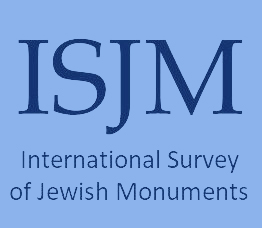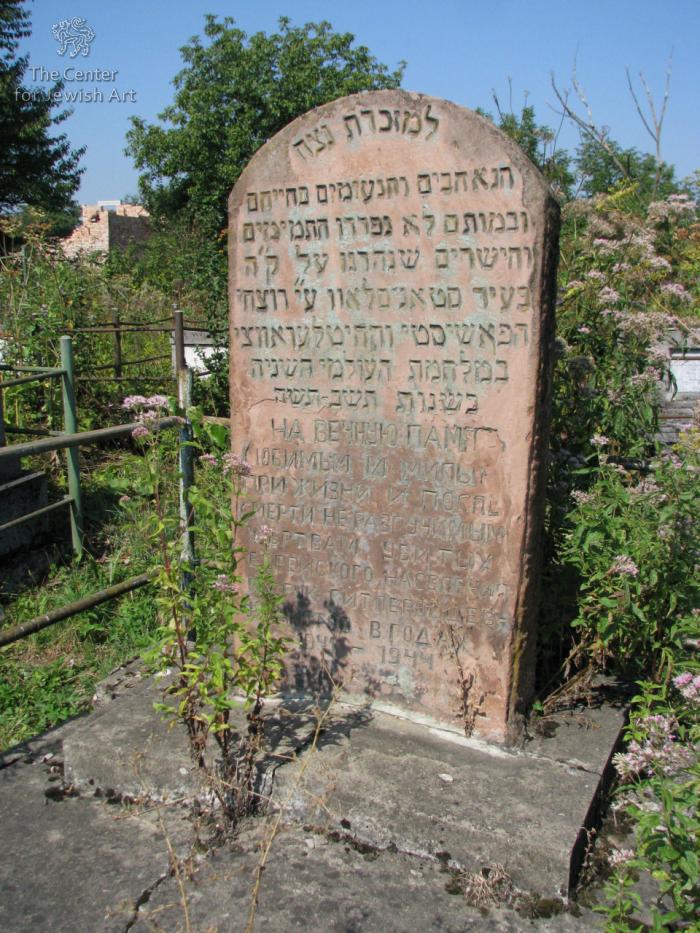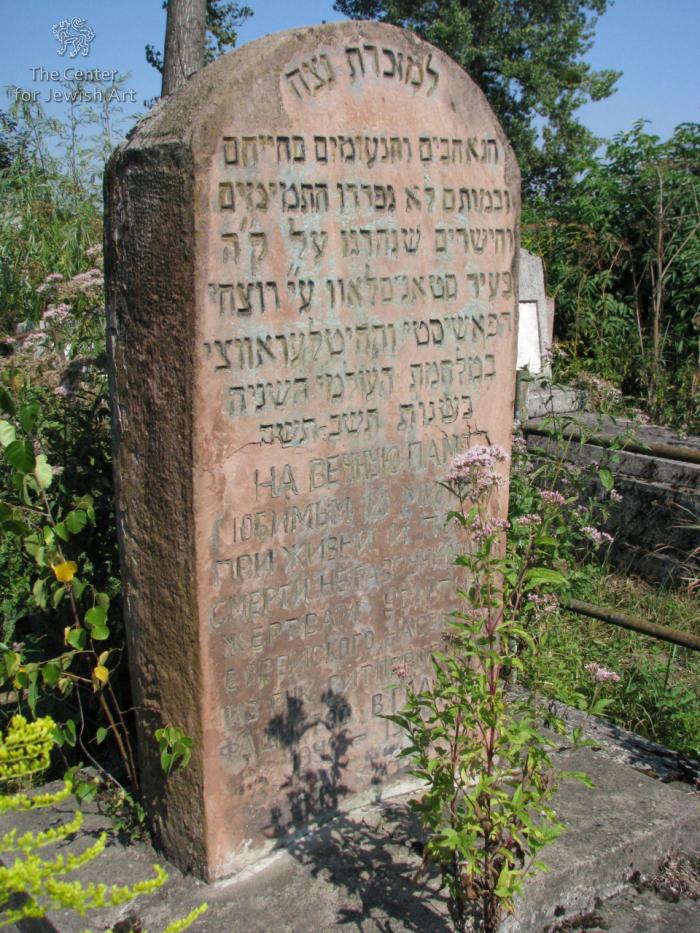Obj. ID: 44711 Old Holocaust Memorial in the New Jewish Cemetery in Ivano Frankivsk, Ukraine, Late 1940s

Memorial name:
No official name.
Who is Commemorated?
Jewish Victims of the Holocaust from Stanisławów
Description
This monument is located in the New Jewish cemetery in Ivano-Frankivsk, among the newest graves. It is designed to not stand out among the other graves in the cemetery. A headstone, carved from pink stone and bearing identical inscriptions in Hebrew and Russian on its front and back, sits atop a concrete base surrounded by a metal fence.
The Hebrew and Russian texts include verses from the Av ha-rahamim prayer introduced into Ashkenazi liturgy after the Crusades. The Russian inscription was compiled by a non-native Russian speaker.
Inscriptions
In Hebrew:
למזכרת נצח
הנאהבים והנעומים בחייהם
ובמותם לא נפרדו [אב הרחמים, מבוסס על שמואל ב א כג] התמימים
והישרים שנהרגו על ק״ה [=קידוש השם]
בעיר סטאניסלאוו ע״י רוצחי
הפשיסטי וההיטלעראווצי
במלחמת העולמי השניה
בשנות תשב - תשה
Translation: To the eternal memory / They were beloved and pleasant in their lifetime, and in their death are not parted [from Him]. [the memorial prayer Av Rahamim, based on II Shmuel 1:23]. Pious / and upright that were killed for sanctification of the name [allusion to the memorial prayer Av Rahamim]/ in the city of Stanislav by Fascist/ killers and Hitlerites / in the Second World War / in the years 1941 - 1945
In Russian:
На вечную память
любимым и милым
при жизни и после
смерти неразлучимым
жертвам убитых
еврейского населения
из рук гитлеровцев
фашистов в годах
1941 - 1944
Translation: To the eternal memory /of beloved and endearing during life and after death inseparable victims [allusion to the memorial prayer Av Rahamim, based on II Shmuel 1:23] / to the victims killed /Jewish people / from hands of Hitlerites, Fascists in the years 1941 - 1944.
Commissioned by
Local Jewish Survivors
In 1931, there were about 140,000 Jews in the whole Stanisławów region [Solovka and Oryshko, p. 69]. In 1939, there were about 26,500 Jews in Stanisławów (now Ivano-Frankivsk) [Solovka and Oryshko, p. 560]. Soviet troops occupied Stanisławów in September 1939. In July, 1941, the Hungarian army entered the city and Nazi Germany control of it in August, 1941 [United States Holocaust Memorial Museum].
On August 3–4, 1941, Nazi Germans killed 2,865 of Stanisławów’s Jews in Gestapo prison and in the forest in Pawełcze (now Pavlivka) [Solovka and Oryshko, p. 139].
On October 12, 1941, between 8,000 and 12,000 Jews were killed in the New Jewish cemetery [Encyclopedia, p. 832].
On March 31, 1942, the first deportations of Jews from Stanisławów to the killing center in Bełżec began [Encyclopedia, p. 832].
On September 12, 1942, the last large mass murder took place on Bandler square in Stanisławów [Solovka].
Jews in Stanisławów were also killed in Rudolf’s mill, where old and sick people were held [Solovka].
On February 23, 1943, the Stanisławów Ghetto was officially liquidated and Stanisławów was announced as “free of Jews”. About 1,500 Jews from Stanisławów survived the war [Encyclopedia, p. 833].
Several Actions took place in the New Jewish cemetery in Stanisławów. The first and largest one took place on October 12, 1941. During the week of April 12, 1942, about 3,000 Jews were brought from Rudolf's mill and killed in the cemetery. Every Saturday from July until October 1942, Nazis brought 500 Jews to the cemetery and shot them. After the official liquidation of the Stanisławów Ghetto on February 23, 1943, mass murders continued in the cemetery. From January 25, 1944, until March 25, 1944, 105 inmates of Janowska concentration camp were forced to excavate the bodies, burn them and crush bones. The exact number of people killed in the New Jewish Cemetery in Stanisławów is unknown [Solovka and Oryshko, p. 139–144].
Estimates of the number of victims of the Holocaust in Stanisławów vary. According to the Soviet Extraordinary State Commission to Investigate German-Fascist Crimes Committed on Soviet Territory, 127,352 Jews perished in Stanisławów. A modern researcher Liubov Solovka considers this amount erroneous and suggests that this amount included all Jews killed in the Stanisławów region without considering Jewish refugees and Jews deported from Hungary. According to Solovka, approximately 40,000 Jews were killed in the New Jewish cemetery in Ivano-Frankivsk [Solovka and Oryshko, p. 560–561].
Memorization activities in the New Jewish Cemetery in Ivano Frankivsk started in the 1940s. This monument was erected by the Local Jewish Survivors [Zeltser]. It is designed to not stand out among the other graves in the cemetery.
A second monument was erected by the Soviet authorities in 1964 ["Ivano-Frankivska oblast"]. The inscription does not specify the ethnicity of the victims and indicates that more than 100,000 Soviet citizens were killed at this place. According to Solovka, it contributed to the emergence of the myth about the number of people killed in the New Jewish Cemetery [Solovka, Liubov and Svitlana Oryshko, p. 460]. The Ivano-Frankivsk Regional Executive Committee included the monument to The List of Monuments of History and Monumental Art of Local Significance in the Ivano-Frankivsk Region by decision no. 612/4 on November 28, 1969 ["Ivano-Frankivska oblast"].
Further memorialization activity took place in Independent Ukraine. In the 2000s, a Memorial to 120,000 victims of the Holocaust was erected by the Local Jewish Community. It is the highest and the most outstanding monument in the cemetery, its inscription does not specify, that all the 120,000 Jews were killed in the New Jewish Cemetery in Ivano-Frankivsk. Therefore, it can be assumed, that it is dedicated to the victims of the Holocaust from the whole Stanisławów region [Solovka and Oryshko, p. 461–462].
There are also two monuments that commemorate smaller Jewish communities. A memorial to Jews from the vicinities of Stanisławów was erected by the Local Jewish Community in the 2000s [Solovka and Oryshko, p. 461–462, 560]. A Memorial to Jews of Bohorodchany was installed in the cemetery by Hasten and Halpern Families in 2002 [Levin].
Encyclopedia of Camps and Ghettos 1933-1945, ed. Martin Dean, vol. 2 (Bloomington: The United States Holocaust Memorial Museum, 2012), pp. 831–834.
Feuerman, Juliusz, “Pamiętnik ze Stanisławowa (1941-1943),” Biuletyn Żydowskiego Instytutu Historycznego 59 (1966): 63-91, https://cbj.jhi.pl/documents/755572/64/ (accessed April 19, 2023)
"Ivano-Frankivska oblast. Skhema planuvannia terytorii (zavershennia). Okhorona nerukhomykh obiektiv kulturnoi spadshchyny", vol. 3 (Kyiv: Derzhavne pidpryiemstvo "Ukrainskyi derzhavnyi naukovo-doslidnyi instytut proiektuvannia mist "Dipromisto" imeni Y.M. Bilokonia", 2015), p. 207., https://www.if.gov.ua/storage/app/sites/24/documentu-2022/ivano-frankivska-oblast-2015-tom-3.pdf (accessed May 3, 2023)
Levin, Vladimir. "Bohorodczany (Brotchin) - after WWII," Jewish Galicia and Bukovina, August 7, 2009, http://jgaliciabukovina.net/134269/article/bohorodczany-brotchin-after-wwii (accessed May 5, 2023)
Solovka, Liubov, "Henotsyd yevreiv Stanislava v roky Druhoi Svitovoi viiny," Visnyk Prykarpatskoho universytetu, IV (2008): 35-43, https://shron1.chtyvo.org.ua/Solovka_Liubov/Henotsyd_ievreiv_Stanislava_v_roky_Druhoi_svitovoi_viiny.pdf? (accessed April 21, 2023)
Solovka, Liubov and Svitlana Oryshko, 150 iz 150 tysiach... Holokost yevreiv Prykarpattia yak skladova etnodemohrafichnoi Katastrofy Skhidnoi Halychyny, (Ivano-Frankivsk: Foliant, 2019), pp. 69, 139–143, 461–462, 560–564.
"Stanisławów," United States Holocaust Memorial Museum, https://encyclopedia.ushmm.org/content/en/article/stanislawow (accessed April 21, 2023)
Zeltser, Arkadi, Unwelcome Memory: Holocaust Monuments in the Soviet Union, trans. A.S. Brown (Jerusalem: Yad Vashem, 2018), pp. 124–125.








